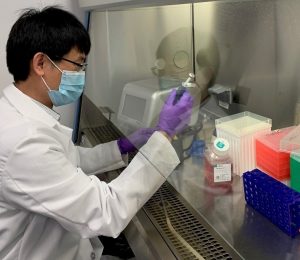Yale scientist’s ‘powerful,’ new gene editing technique promises to speed research
CT Insider — New Haven, CT (February 21, 2023) A new gene editing technique developed by scientists from Yale University offers a powerful new tool to interrogate how genes work across a swath of biological disciplines, from cancer research to immunology. According to a study published in Nature Biotechnology, the technique called “CLASH” allows potentially thousands of genes to be tested at once, dramatically scaling up the speed of experimentation.
“It’s really simple nowadays to knock out or take a gene out, but it’s a lot harder to insert DNA,” said Sidi Chen, a 2021 PSSCRA winner and professor of genetics at Yale who developed the technology. “To scale up to high throughput is even harder, previously unthinkable.
Dr. Robert Sobol, the co-leader of the cancer biology program at Brown University, said, “It’s pretty impressive. This adds a whole new dimension to systems analysis in biology.”
The gene-editing technique combines older techniques in a two-step process that lets scientists add many variants on the same gene to test organisms in parallel. As Chen explained, CLASH combines two technologies made famous by the COVID-19 pandemic, an mRNA vector and a viral vector. It works sort of like cut and paste.
“The mRNA is actually the scissors. It encodes the enzyme that cuts,” said Chen. “And the adenovirus vector is the paste. Inserting the gene precisely where we want.”

The mRNA delivers a copy of CRISPR, the now-famous DNA-clipping enzyme that dominated science news over the last ten years. Target cells are made to take up, and make the CRISPR enzyme. At the same time, an adenovirus vector, the same delivery mechanism for the Johnson and Johnson COVID-19 vaccine, injects a targeting RNA and a new strand of DNA into the cell. These viruses have been engineered to be unable to replicate. They are, effectively, hollow viruses used as delivery vehicles.
The target sequence from the virus guides the newly made CRISPR enzyme to a gene and slices out. The new gene is then added to the gap left behind by CRISPR. Cut and paste. This allows scientists studying genes to replace specific genes relatively easily and with high accuracy. One of the major problems in genetic engineering is dealing with off-target effects. This is especially true in older gene editing technologies like viral vectors.
When a virus inserts a gene into the genome, it does so randomly, which can have a disruptive, or lethal, effect on the cell. The CLASH technique prevents this kind of randomness. It also allows multiple genes to be studied at once. By giving each viral vector a unique gene, a scientist can study the effects of many different genes simultaneously.
Dr. Chen’s team used genetically modified, cancer-fighting T-cells as a proof of concept. By making many different edits to his T-cells in parallel, and introducing them to test animals with tumors, Chen could test multiple genes intended to train T-cells to attack solid tumors at the same time in an experimental CAR-T therapy. CAR-T is a therapy that takes a patient’s own white blood cells and reprograms them to attack cancer cells.
Since CAR-T was introduced, it has been effective at treating “liquid” tumors like lymphomas, but solid tumors have been harder to deal with. This experiment tested multiple gene edits in tandem to see which ones would help the modified immune cells attack solid tumors.
“In many cases, we’re not smart enough to guess what works, so biologically how do you tell?” Sobol said. He said that running all those tests in parallel combined with significant edits was “powerful.”
“Things that we normally had to do one-by-one, we can now do hundreds at a time,” said Sobol. “I think there’s going to be a lot of utility to this.”
Chen anticipates that this approach to gene editing will be useful for attacking complex genetic problems. Testing many modifications to a single gene at once can illustrate complicated networks of genetic interaction.
“We’re primarily interested in immunology, T-cell therapy, that can keep us busy for a while,” Chen said. “But we can certainly go beyond.”